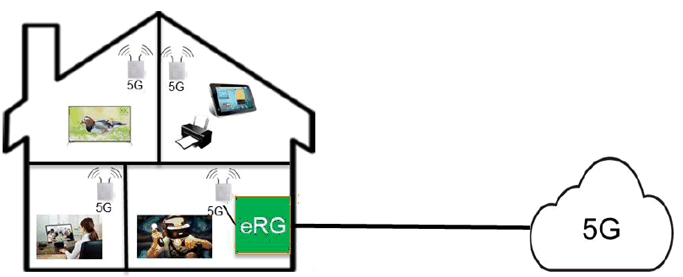Content for TR 22.858 Word version: 18.2.0
6 Traffic Scenarios p. 45
6.1 Traffic Scenario: inHome p. 45
6.1.1 Description p. 45
Many houses suffer from problems of coverage due to the number of floors and other obstacles (i.e. walls, doors, columns, furniture). Outdoor-to-indoor coverage may be an issue at 3.5 GHz and will certainly be difficult at mmwave frequencies. Providing coverage with indoor solutions may be the answer; Premises Radio Access Stations (PRASs) can be connected via fixed access. 3GPP together with BBF has provided Wireline Wireless Convergence architecture solutions where fixed access is considered part of the 5G System.
Most houses have only one entry network point where the evolved Residential Gateway (eRG) will be installed. Connectivity to the eRG may be fixed access, 5G Fixed Wireless Access, or a hybrid of both.

Providing connectivity throughout the house from a single PRAS will not be feasible. Concrete floors and walls, will require multiple PRASs to be deployed in the house. That way it can be guaranteed that even in the attic, cellular and garage, there is sufficient coverage. At mmwave frequencies, even a PRAS per room (living room, kitchen, bed rooms, attic) may be required as higher frequencies will be blocked significantly by walls, et cetera.
6.1.2 Assumptions p. 45
Let's consider a fairly large house with dimensions 10m x 10m and 3 floors. The owners of the house are a family of four; mother, father and two teen age children.
The traffic scenario for in the house is mainly determined by multimedia application usages. Most other services (e.g. mobile telephony) will not significantly contribute to the traffic load.
We assume the house has two UHD TVs, two VR headsets for gaming, and two office settings for working from home (for e.g. multimedia conferencing). Not all devices will be used at the same time. On the other hand, visitors may also bring/use devices. Assumption is that one UHD TV, two VR headsets for gaming and two office settings are used simultaneously, each at the maximum user experienced data rates of 1 Gbit/s DL and 500 Mbit/s UL. This results in an overall capacity for the house of 5 Gbit/s DL (UHD TV is DL only) and 2 Gbits/s UL.
The assumption is that different Premises Radio Access Stations (PRASs) are deployed around the house. Not all devices will use the same PRAS. Maximum per PRAS data rates are assumed to be half of that per house.
6.1.3 Potential Functional Requirements p. 46
None
6.1.4 Potential Key Performance Requirements p. 46
Values for max data rate and area capacity per home are based on values in TS 22.261 for InHome scenario and indoor hotspot. The area capacity per base station is calculated based on two base stations per home (10m x 10m with 3 floors).
| Scenario | Max. data rate
(DL) |
Max. data rate
(UL) |
End-to-end latency | Area traffic capacity
(DL) (note 1) |
Area traffic capacity
(UL) (note 1) |
Area traffic capacity
(DL) (note 2) |
Area traffic capacity
(UL) (note 2) |
Area |
|---|---|---|---|---|---|---|---|---|
| InHome Scenario | 1 Gbit/s | 500 Mbit/s | 10 ms | 5 Gbit/s/ home | 2 Gbit/s /home | 2.5 Gbit/s/ PRAS | 1 Gbit/s/ PRAS | 10mx10m - 3 floors |
|
NOTE 1:
Area traffic capacity is determined by high bandwidth consuming devices (e.g. ultra HD TVs, VR headsets, …) assuming a family of 4 members (one UHD TV with DL only and 4 high bandwidth consuming devices with UL and DL used simultaneously).
NOTE 2:
Multiple Premises Radio Access Stations (PRASs) are assumed (e.g. one per room), maximum traffic per PRAS assumed to be half of the overall traffic per house.
|
||||||||